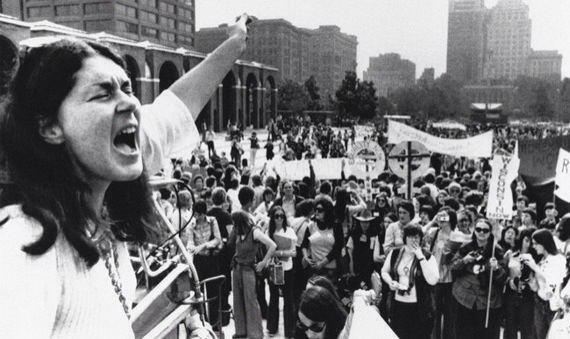DeCrow raised eyebrows in 1981 when she served as defense counsel to Frank Serpico, the former New York detective and whistleblower, in a paternity suit. Serpico claimed the plaintiff had used him as a “sperm bank” and lied about being on the Pill while knowingly trying to conceive, and asserted that he had a constitutional right not to become a parent against his will. (The family-court judge, a woman, ruled in Serpico’s favor, but he lost on appeal.)
DeCrow, by then a lawyer in private practice in Syracuse, New York, endorsed Serpico’s argument on feminist grounds. “Just as the Supreme Court has said that women have the right to choose whether or not to be parents, men should also have that right,” she told The New York Times, calling this “the only logical feminist position to take.”
Quite a few feminists disagreed. Marjory D. Fields, then co-chair of Governor Mario Cuomo’s Task Force On Domestic Violence and later a family-court judge, described the defense tactics in the case as “almost a classic antiwoman presentation: that women seduce and entrap men with their feminine wiles.” DeCrow was unfazed. In a 1982 letter to the Times, she wrote that since men have no legal power to either veto or compel an abortion, it is only just that they shouldn’t have to pay for a woman’s unilateral decision to bring the pregnancy to term: “Or, put another way, autonomous women making independent decisions about their lives should not expect men to finance their choice.”
DeCrow also championed men’s rights as fathers, arguing for a “rebuttable presumption” of shared custody after divorce. She worked with the Fathers’ Rights Association of New York State and joined the board of the Children’s Rights Council, a pro-joint custody group. More recently, she was on the board of Leading Women for Shared Parenting. (In an ironic twist, one of her fellow LW4SP board members was her old nemesis Phyllis Schlafly, whom DeCrow frequently debated on college campuses in the 1980s and 1990s.)
Again, DeCrow framed her position as a feminist one, arguing that getting men more involved in parenting was essential if women were to achieve equality in other pursuits. (A good explanation of her views on the subject is in a 1982 speech she gave to the National Congress of Men, reprinted in the newsletter of the Greater Syracuse chapter of NOW.) Plenty of feminists have endorsed this idea when it comes to things like equal parental leave or shared responsibility for housework and child care; Gloria Steinem has said that “women are not going to be equal outside the home until men are equal in it.” But few were willing to take the extra step of framing custody in terms of men’s rights, or siding with men against women who wanted sole custody.
DeCrow was willing to do it, and to say that many divorced mothers whose professional lives would benefit from shared custody were unreasonably opposed to this option—not only because of the social stigma of being viewed as “bad moms” but out of sheer hostility toward their ex-husbands. In a 1984 Father’s Day column, DeCrow described a conversation with a client, a divorced mother of three who was having childcare troubles because of an unusual work schedule: “‘What about the father?’ I asked. ‘Is he willing to take them during those hours?’ ‘Their father?’ she exclaimed. ‘That’s just what he wants!’”
To some feminists, this may sound like a troubling echo of misogynistic stereotypes of the spiteful ex-wife; but to DeCrow, it was a human issue, not a “gendered” one. In a 1994 interview, she lamented that “in the battle between the sexes, men and women will go practically to the end of the earth in illogical, irrational ways to give each other pain.” It’s telling that DeCrow saw such behavior as mutual; she was also sympathetic to the controversial argument that domestic violence is a two-way street. In the 1970s, she had fought sexist rape laws that allowed victims to be questioned about their chastity; in the early 1990s, she applauded Katie Roiphe’s critique of “rape-crisis feminism,” The Morning After, as a courageous challenge to a “new puritanism” that depicted women as perpetual victims of male predation. Recalling the bad old days when girls were taught to deny both their brains and their sexuality, DeCrow was tangibly impatient with the idea that “being whistled at, or even slurped at” amounted to “oppression.”
There were other heresies, too. DeCrow, who started her feminist journey by fighting sex discrimination in the workplace, contributed a foreword to Warren Farrell’s 2005 book, Why Men Earn More, which argued that the pay gap is due largely to men’s and women’s different workplace behavior and career choices; understanding these patterns, DeCrow believed, could help women’s advancement. The message aside, she was quietly bucking the party line by the mere fact of her collaboration with Farrell, who served on the board of NOW’s New York City chapter during her presidency but was excommunicated from the women’s movement over his championship of men’s liberation.
DeCrow herself was increasingly at odds with the organization she had once led, though she never broke with it. By the mid-1990s, NOW was openly hostile to the fathers’-rights movement, arguing that women were the real victims of bias in family courts. An “action alert” issued at the group’s 1996 annual conference compared fathers’-rights activists to batterers seeking control over women; a resolution three years later made it NOW’s official policy to champion women’s interests in divorce and custody cases and counter the “undue influence” of fathers’ group. DeCrow, then head of NOW’s Greater Syracuse chapter, refrained from criticizing these moves. In 2000, she told me she had heard about the resolution but hadn’t read it and couldn’t comment. In his tribute to DeCrow on LW4SP’s blog, Farrell wrote that she “walked [a] tightrope,” not wanting to alienate feminist friends and colleagues.


